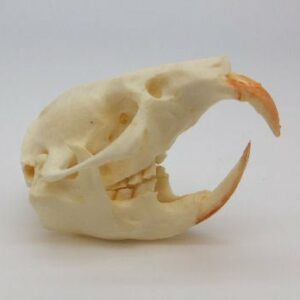All items sold on this website are polyurethane resin replicas, made in USA. No real or natural bone is available on this site.
Tachyoryctes splendens Skull Replica measures 1.7 inches. Tachyoryctes splendens Skull Replica is Museum quality replicas Polyurethane cast made in USA. 2-part skull (separate cranium and jaw). Known as Northeast African Mole Rat. Our precise skull can be used as a teaching tool, museum skull exhibit, home decor skull, or office decor skull.
The Northeast African Mole Rat or Tachyoryctes splendens is a species of rodent in the family Spalacidae and is found in Ethiopia, Somalia, and northwest Kenya.
Its natural habitats are subtropical or tropical moist montane forests, dry savanna, high-altitude shrubland and grassland. It lives a solitary existence underground and produces a small litter of pups twice a year, in the two rainy seasons.
The Tachyoryctes splendens is a fossorial species and lives a solitary life in a network of burrows. African mole rats mainly use their bulging teeth, nose, and top of their head to dig channels underground.
Some researchers found that their olfactory systems have increased surface area and are highly complex, an evolved trait that may have occurred due to their lifestyle of living in a community with less individuals.
Female Tachyoryctes splendens become sexually mature at about 120 days and the average time between successive litters is around 173 days. The average size of litters is about two. The arrival of the young is synchronized with the middle of the rainy seasons which occur from April to July and again from November to December.
Sometimes areas where this mole rat lives can become flooded. Tests have shown that when this happens, the Tachyoryctes splendens can swim for two minutes or more, walk overground for up to 260 ft. at 23 ft. per minute and dig a new burrow.
The researchers hypothesized that flooding might encourage the animal to disperse to new areas and that the wet ground would make digging the new burrow easier.
The Tachyoryctes splendens can produce seismic signals by striking its head against the ceiling of their tunnels to communicate. These signals can be fast, probably for identification of individuals, or slow, maybe as a warning.
The Northeast African mole-rat is common across most of its range and its population seems stable. It does not face any major threats and for these reasons, the IUCN lists it as being of “Least Concern” in its Red List of Threatened Species, although the IUCN has evaluated the species in the larger view of the East African mole-rat, lumping a number of species in the genus.


